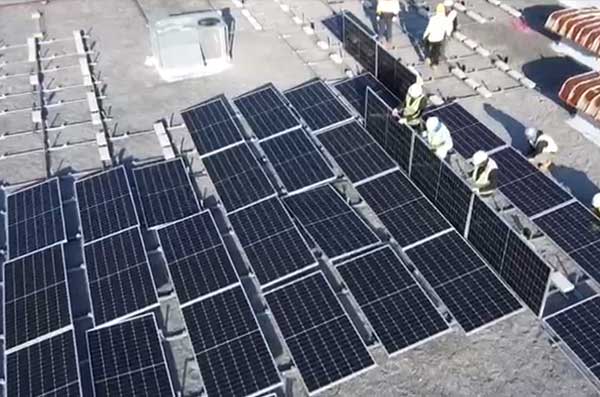Commercial solar panel efficiency is determined by multiple key factors. Solar cell technology, including monocrystalline, polycrystalline, and thin-film options, significantly impacts performance. Panel material quality, particularly silicon grade and anti-reflective coatings, improves energy conversion. Proper installation orientation and angle maximize sunlight capture. Environmental conditions, such as temperature and shading, affect output. Regular maintenance practices, including cleaning and inspections, sustain peak efficiency. The age of the system and natural degradation also influence long-term performance. Understanding these factors is essential for maximizing the efficiency and longevity of commercial solar installations. A deeper exploration of these elements reveals strategies for improving solar energy systems.
Solar Cell Technology Types
Solar cell technology types form the foundation of commercial solar panel efficiency. The selection of appropriate technology significantly impacts overall solar energy generation and system performance. Monocrystalline solar cells stand out for their high efficiency, typically exceeding 20%, due to their single-crystal structure that maximizes electron movement and energy conversion. Polycrystalline solar cells offer a cost-effective alternative, achieving efficiencies of 15-20%, but with reduced performance in high-temperature conditions.
Thin-film solar cells provide flexibility and lightweight advantages, with efficiencies ranging from 7% to 18%. While less space-efficient than crystalline options, they suit specific applications where traditional panels are impractical. Bifacial solar panels represent an innovative approach, capturing sunlight from both sides and potentially increasing energy output by up to 30% in ideal conditions.
PERC technology improves solar panel efficiency by adding a reflective layer to traditional cells, enhancing efficiencies by 1-2%. This advancement in solar cell technology demonstrates the ongoing efforts to maximize energy conversion and overall system performance. As the industry continues to evolve, these diverse solar cell technologies offer varying benefits, allowing for tailored solutions in commercial solar panel applications.
Panel Material Quality
How does the quality of materials used in solar panels impact their overall efficiency? The efficiency of solar panels is directly correlated with panel material quality. Monocrystalline panels, utilizing high-grade silicon, achieve efficiencies exceeding 20%, outperforming polycrystalline panels (up to 15%) and thin-film panels (7-18%). Superior materials improve light absorption and energy capture, significant factors in panel performance.
Anti-reflective coatings on solar cells significantly boost light absorption, increasing overall efficiency. PERC technology, incorporating additional layers to reduce electron recombination, further improves energy conversion. The durability of materials, such as tempered glass and high-grade aluminum frames, guarantees sustained performance over time, maintaining efficiency throughout the panel’s lifespan.
Component quality extends beyond the panel itself. High-quality solar inverters play an essential role in optimizing the energy conversion process, contributing to system efficiency. Regular maintenance of these components is fundamental for maximizing performance.
Installation Orientation and Angle
While material quality forms the foundation of solar panel efficiency, proper installation orientation and angle significantly amplify their performance. For commercial solar panels, ideal orientation is essential to maximize sunlight exposure and energy capture. In the Northern Hemisphere, panels should face south, while in the Southern Hemisphere, a northward orientation is preferable. The tilt angle must be carefully calculated based on geographic latitude to guarantee maximum efficiency.
| Location | Latitude | Ideal Tilt Angle |
|---|---|---|
| St. Louis | 38.6°N | 32.5° |
| Little Rock | 34.7°N | 29.5° |
| Miami | 25.8°N | 25.8° |
| Seattle | 47.6°N | 37.6° |
Correctly oriented and tilted panels can improve energy capture by 15-20% compared to poorly positioned installations. Seasonal variations should also be considered, with steeper angles in winter enhancing sunlight capture during shorter days. Additionally, avoiding shade obstruction from nearby structures or vegetation is vital, as shading can reduce solar panel efficiency by up to 50% or more. Commercial solar panel installations must prioritize proper orientation and tilt angle to maximize energy production and return on investment.
Environmental Conditions
Numerous environmental factors significantly influence the efficiency of commercial solar panels, with temperature being a primary consideration. Higher temperatures can adversely affect solar panel performance by reducing voltage output and overall efficiency. This emphasizes the importance of considering local climate conditions when designing and implementing commercial solar installations.
Shade from nearby structures, trees, or debris presents another vital environmental challenge, potentially decreasing solar energy capture substantially. Ideal placement of panels is essential to minimize shading effects and maximize efficiency. Additionally, the accumulation of dust, dirt, and other particulates on panel surfaces can impede light absorption, necessitating regular cleaning to maintain peak performance.
Weather events, such as heavy snowfall or dust storms, can temporarily obstruct sunlight and hinder electricity generation until conditions improve. To mitigate these effects, proper panel angle and orientation must be carefully calculated based on local geographical and climatic factors. This guarantees maximum sunlight exposure throughout the year, accounting for seasonal variations and enhancing overall system efficiency. By addressing these environmental conditions, commercial solar installations can achieve and maintain ideal performance levels.
Temperature Effects
Temperature stands as a primary factor influencing the efficiency of commercial solar panels. While solar panels can operate across a wide temperature range, their performance is significantly affected by thermal conditions. Contrary to intuition, ideal performance typically occurs at cooler temperatures rather than extreme heat.
High temperatures can reduce the efficiency of solar panels, as indicated by their temperature coefficient. This metric, usually ranging from -0.3% to -0.5% per degree Celsius, quantifies the decrease in output as temperatures rise. While panels can function effectively up to 180°F (82°C), exceeding this threshold can lead to overheating and diminished energy output.
Conversely, solar panels may still generate electricity at temperatures as low as -22°F (-30°C), though snow or ice accumulation can impede performance. To mitigate the negative temperature effects and maintain efficiency during hot weather conditions, proper installation techniques are essential. Enhancing airflow around panels through strategic positioning and mounting can help dissipate heat and prevent overheating. By implementing these measures, commercial solar installations can enhance their energy output across varying temperature conditions.
Shading and Obstructions
Shading’s impact on commercial solar panel efficiency cannot be overstated. Studies indicate that even partial shading can lead to a staggering 80% decrease in solar panel output. This significant reduction in efficiency underscores the vital importance of ideal panel placement, avoiding any obstructions during peak sunlight hours, typically between 9 AM and 3 PM.
The effects of shading on solar panels are complex and non-uniform. Various factors, including the location and angle of obstructions, can result in differing efficiency losses across a solar panel system. To mitigate these issues, commercial installations may employ shade-tolerant technology, albeit at a higher initial cost. Regular maintenance is essential to guarantee maximum solar energy capture, including:
- Evaluating surrounding structures for potential shading
- Trimming vegetation to prevent obstruction
- Monitoring panel performance for efficiency drops
- Implementing shade mitigation strategies
- Conducting periodic site evaluations
To maximize efficiency, commercial solar installations must prioritize strategic panel placement, considering both current and potential future obstructions. By addressing shading concerns proactively and implementing appropriate technological solutions, businesses can enhance their solar energy systems and maintain high levels of efficiency over time.
Maintenance Practices
Maintaining ideal efficiency in commercial solar panel systems requires a comprehensive and proactive approach to upkeep. Regular maintenance practices are essential for preserving the efficiency of solar panels and guaranteeing peak performance over time. A key component of these practices involves cleaning solar panels every six months to remove accumulated dirt and debris that can obstruct sunlight exposure and reduce energy production.
Monthly damage inspections are important for identifying potential issues such as corrosion, debris accumulation, and rodent activity that may compromise solar energy systems. Additionally, addressing shading from vegetation through regular trimming of trees and shrubs prevents significant reductions in energy output. Implementing a routine maintenance schedule, particularly during fall and spring, facilitates timely resolution of efficiency-impacting issues.
Performance monitoring plays a critical role in maintenance practices, enabling early detection of efficiency problems and allowing for prompt corrective actions. By consistently adhering to these maintenance practices, commercial solar panel operators can maximize energy production and extend the longevity of their systems. This proactive approach guarantees that solar energy systems maintain their efficiency and continue to provide peak performance throughout their operational lifespan.
Age and Degradation Factors
Over time, commercial solar panels experience natural aging and degradation processes that affect their efficiency. The age of the solar installation plays an essential role in determining its overall performance. Typically, solar panels maintain their rated efficiency for approximately 25 years, after which they begin to degrade at an average rate of 0.5% to 0.7% annually. This degradation rate impacts the long-term efficiency of the solar system, although panels continue to produce electricity beyond this period.
Several factors influence the degradation rate and performance of solar panels:
- Environmental conditions (temperature, humidity, pollution)
- Quality of materials used in panel construction
- Installation techniques and positioning
- Maintenance practices and frequency
- Technological advancements in panel design
High-efficiency solar panels may exhibit slower degradation rates due to superior materials and construction. Regular inspections and maintenance can mitigate issues that accelerate degradation, ensuring peak performance throughout the panels’ lifespan. Manufacturers often provide warranties guaranteeing rated production output for 25 years, offering assurance against significant efficiency drops during this period. Understanding these age and degradation factors is essential for accurately predicting long-term system performance and planning for potential replacements or upgrades in commercial solar installations.
Frequently Asked Questions
What Are the Factors Influencing Solar Panel Efficiency?
Solar panel efficiency is influenced by multiple factors. Installation techniques, including proper orientation angle and system design, are essential. Environmental conditions such as shading effects and temperature changes impact performance. Panel materials and inverter quality determine conversion rates. Maintenance practices, like regular cleaning, preserve ideal functionality. Energy storage solutions can improve overall system efficiency. Additionally, site-specific factors such as latitude, altitude, and local climate patterns play significant roles in determining the effectiveness of solar installations.
What Is the Efficiency of Commercial Solar Panels?
Like a garden’s yield depends on various factors, commercial solar panels’ efficiency is a complex interplay of elements. Typically, these photovoltaic technology marvels achieve 15-22% efficiency in energy conversion. High-end solar power systems can exceed 22%, thanks to advanced module design. Efficiency is influenced by temperature effects, sunlight exposure, and maintenance practices. Grid connection, performance monitoring, and financial incentives also play roles in optimizing commercial solar panel efficiency, making it a multifaceted aspect of modern sustainable energy solutions.
What Does the Efficiency of Solar Panels Depend On?
The efficiency of solar panels depends on multiple factors within solar panel technology. Key determinants include material quality, temperature effects, panel orientation, and installation angle. Environmental conditions, such as shading impact and light wavelength, significantly influence performance. Inverter efficiency plays a vital role in converting DC to AC power. Additionally, maintenance practices are essential for sustaining ideal output. These interconnected variables collectively determine the overall effectiveness of solar energy conversion in photovoltaic systems.
How to Increase the Efficiency of Solar Panels?
Solar tracking systems can boost energy capture by up to 30%, significantly enhancing panel efficiency. To increase solar panel efficiency, implement regular maintenance, including thorough cleaning techniques to remove debris. Guarantee ideal installation with proper orientation adjustments and minimize shading impact. Consider temperature effects and employ high-quality inverters. Material advancements in photovoltaic technology continually improve efficiency. Integrate energy storage solutions to maximize utilization of generated power. Regular inspections and proactive maintenance are essential for sustaining peak performance in solar energy systems.

